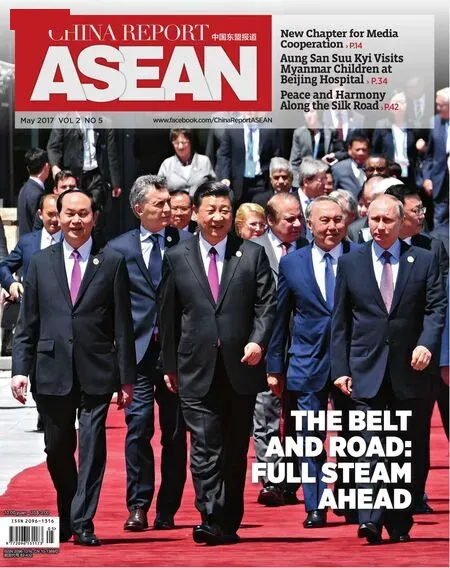PHILIPPINE AMBASSADOR TO CHINA: ECONOMIC POLICY IN LINE WITH THE BELT AND ROAD
By
PHILIPPINE AMBASSADOR TO CHINA: ECONOMIC POLICY IN LINE WITH THE BELT AND ROAD
ByZhao Jun, Tan Xingyu, Wang Jiping
In an exclusive interview, Philippine Ambassador to China Jose Santiago Sta. Romana speaks on importance of Chinese-invested infrastructure projects

Jose Santiago Sta. Romana, the Philippine Ambassador to China.
Philippine President Rodrigo Duterte was present in Beijing on May 14-15 for the Belt and Road Forum for International Cooperation, which gave the Philippines an opportunity to showcase itself as a growing economic power in Asia. 2017 is indeed an important year for the Philippines, when the country serves as chair of ASEAN and introduces many of Duterte’s new policies. In light of the country’s fresh prominence on the global stage, China Report ASEAN sat down for an interview with Jose Santiago Sta. Romana, the Philippine Ambassador to China, to discuss the Belt and Road Initiative and the future of the Philippines.
>> China Report ASEAN: What is your opinion of the Belt and Road Forum?
Ambassador Sta. Romana:
Firstly, I think the Belt and Road Forum is a very good opportunity for the Philippines to learn more about the Belt and Road Initiative, because I have to admit that we actually have a limited understanding about it.
From the viewpoint of our economic development, we appreciate the Belt and Road Initiative. We now have a very good relationship with China and we want to strengthen bilateral cooperation with China in many areas, especially in the economic fi eld.
Moreover, we think there are similarities between the Dutertenomics of President Duterte and China’s Belt and Road Initiative. I believe those similarities will provide areas of convergence for Philippine and Chinese development.
For example, facilitating connectivity is a priority area for implementing the Belt and Road Initiative, which encourages countries along the Belt and Road to improve the connectivity of their infrastructure plans, while infrastructure construction is the focus of Dutertenomics.
>> China Report ASEAN: From your understanding, what is the role that ASEAN may take in the construction of the Belt and Road?
Ambassador Sta. Romana:As chair of ASEAN this year, the Philippines hopes to establish links between ASEAN’s Master Plan on Connectivity 2025 and the Belt and Road Initiative.
ASEAN is now promoting free trade and hopes to promote development in various sectors such as industry and agriculture. Moreover, ASEAN has long been seeking cooperation with other countries to expand its markets.The establishment of the China-ASEAN Free Trade Area is a typical example.
The realization of the Belt and Road Initiative will provide ASEAN a bigger platform to connect to the world market. Thus, there will be more opportunities for trade and investment for ASEAN countries. Finally, the people in ASEAN will derive more benef i t, including the realization of enhanced people-to-people exchanges. Of course, there will be challenges along the way, but I think these are surmountable.
Finally, I want to highlight that the Philippines and ASEAN are most concerned with further economic development and improvement of living standards for the people in the region. These are also the priorities of the Belt and Road Initiative, and this is why ASEAN can play an active role in it.
>> China Report ASEAN: Which are the areas that the Philippines wants to cooperate with China the most this year?
Ambassador Sta. Romana:
Infrastructure is a very important area for Philippines-China cooperation. Before the Belt and Road Forum, President Duterte and President Xi Jinping already agreed to cooperate in three projects this year, which are supported by Export-Import Bank of China.
These include an irrigation project in the Northern Philippines called the Chico River Down Project, a reservoir project for improving the water supply in Manila, the capital city of the Philippines, and a railway project that would improve logistics, shorten travel time and reduce transportation costs.

On Nov. 29, 2016, Philippine President Rodrigo Duterte (fourth from left) attended the inauguration ceremony of a drug abuse treatment and rehabilitation center in Fort Magsaysay, the Philippines. Funding for the construction of the center was donated by Chinese entrepreneur Huang Rulun.
In addition to the projects I just mentioned, there are also two projects involving Philippines-China cooperation, which is supported by the Asian Infrastructure and Investment Bank (AIIB). One is a Rapid Bus Transit system to improve traffic fl ows in Manila, and the other is to improve fl ood-control in Metro Manila, where 12-15 million people live. Finally, China will build two bridges across the Pasig River, a main river in Metro Manila, to alleviate traffic congestion.
Aside from infrastructure, our two countries have also agreed to cooperate in the trade of fruits and agricultural products, tourism, education and other areas. I believe with the improvement in logistics along the Belt and Road, more Philippine fresh fruits like bananas, coconuts, pineapples and mangos will be exported to China and neighboring regions.
>> China Report ASEAN: To promote the bilateral relationship between China and the Philippines, what kind of efforts will your embassy make in the second half of this year?
Ambassador Sta. Romana:We have noticed that more and more Chinese companies want to invest into the Philippines and are keen on looking for good investment projects. Meanwhile, there has been an increase in partnership of Philippine and Chinese companies to pursue economic opportunities in bigger markets. So, for the rest of this year, we will focus on matching Philippine and Chinese companies. For example, we will look into establishing a website in Chinese to facilitate business matching and increase awareness of Philippine companies and products to Chinese investors and consumers.

